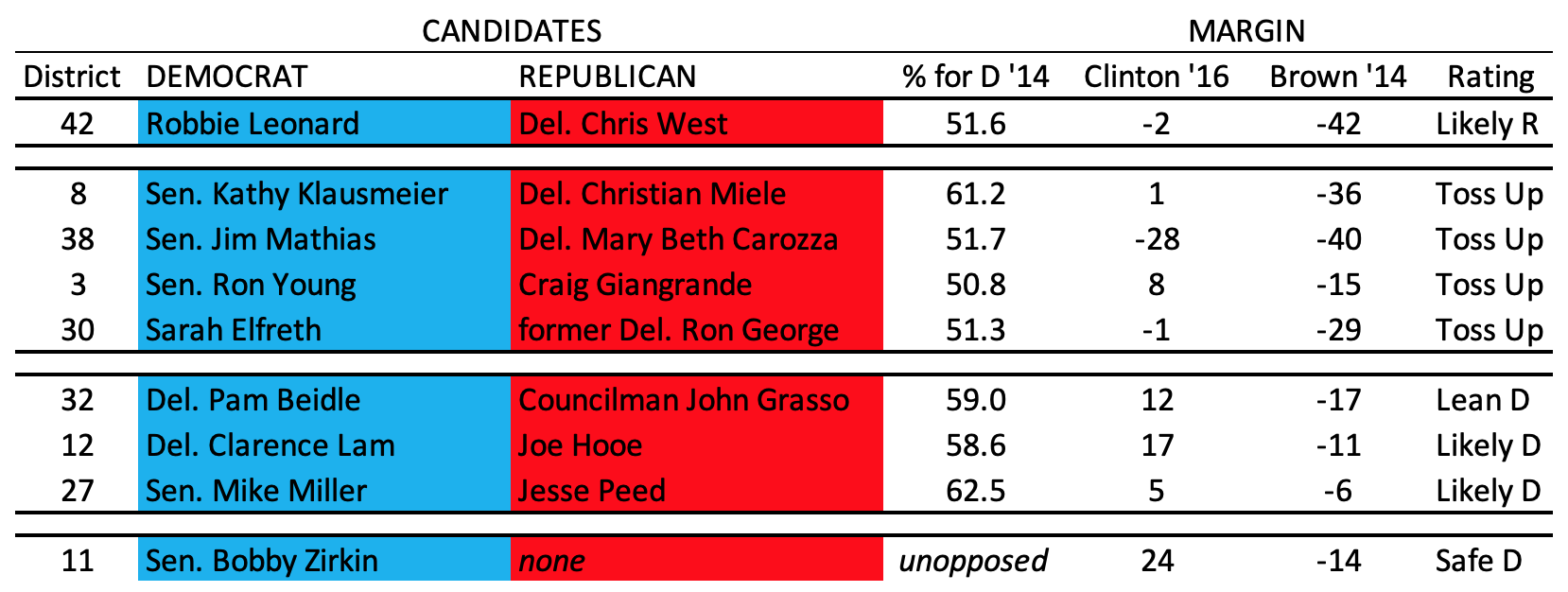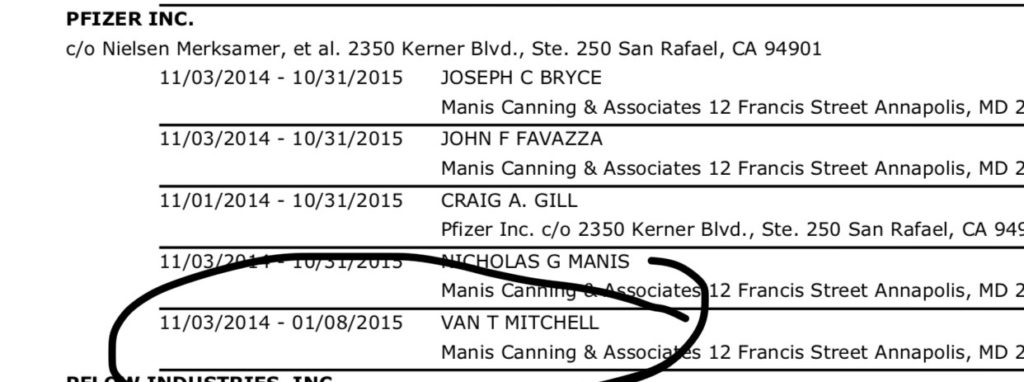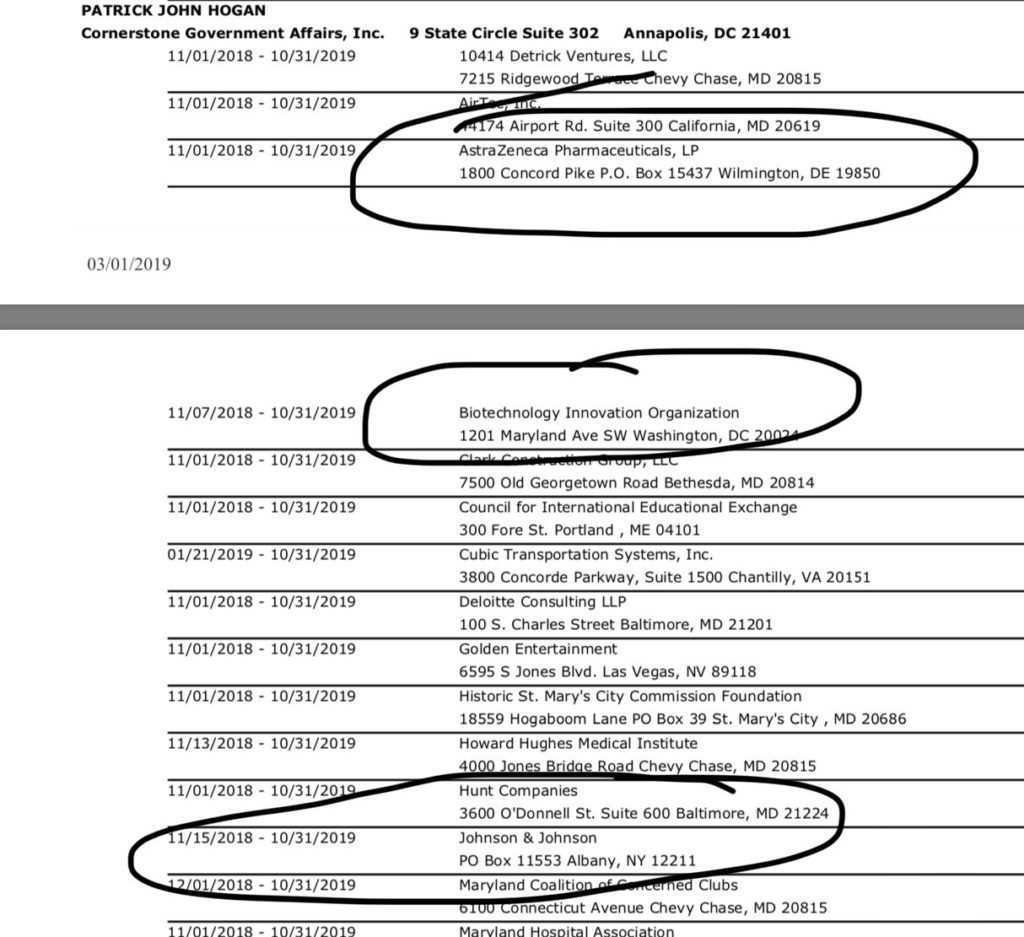
Earlier tonight, I detailed the list of 24 safe Democratic and 14 safe Republican seats in the General Assembly. Included on that list was any seat that the appropriate party swept in (1) the 2014 gubernatorial election, (2) the 2016 presidential election, and (3) the 2014 state legislative elections.
Sen. Bobby Zirkin (D-11) should really have been included on the safe list, as he enviably has no opponent. Though Hogan won the seat by 14 in 2014, Republicans evidently decided not to take on Zirkin in this seat won by Clinton by 24 in 2016.
That leaves eight vulnerable Democratic seats. Republicans need to net five to gain enough seats to uphold a veto should Larry Hogan win election to a second term tomorrow. Today’s scorecard ranks them from most to least vulnerable:
1. District 42 (OPEN) Likely Republican
This Baltimore County district meanders from the City to the Pennsylvania border. Sen. Jim Brochin (D), the most moderate member of the General Assembly, gave up his seat to run for Baltimore County executive. He lost the Democratic nomination by just a hair to Democrat Johnny Oleszewski.
An astute campaigner, Brochin nevertheless held the seat with just 51.6% in 2014. That Brochin held it at all is a credit to his skills. Hogan won it by 42 points-more than any other seat on this list of vulnerable Democratic seats.
Republican Del. Chris West (R-42B) already represents two-thirds of the district and hopes to move to the Senate. Robbie Leonard, his opponent, is a former chair of the Baltimore County Democratic Central Committee. It’s hard to see how Leonard wins in a district that Clinton lost narrowly in 2016 and that Hogan will likely take by even more in 2018 than four years ago. But anything is possible if Democrats perform strongly enough tomorrow.
Early Vote + Returned Absentees: 54% D, 32% R, 13% other.
2. District 8 (Kathy Klausmeier) Toss Up
Though not the most Republican seat on this list, Sen. Kathy Klausmeier is nonetheless the most vulnerable incumbent Democrat running for reelection. She is facing her toughest contest yet as she hopes to fend off Republican Del. Christian Miele.
This east Baltimore County district barely went for Clinton in 2016 just two years after Hogan won it by 36. In many ways, it resembles neighboring District 6, which had long been held by Democrats until it fell to a Republican sweep in 2014 and took down Johnny O’s Senate ambitions with them.
While D6 is 6% more African American than D8, it too has many white voters who find Trump appealing and among whom Hogan is the consensus choice. Miele is a strong candidate with fewer vulnerabilities than other Republican challengers, notwithstanding his odd links to marijuana lobbyist Max Davidson.
Republicans already hold two of the delegate seats. One wonders if any less well attuned Democrats than Sen. Klausmeier and Del. Bromwell would have a shot in a district that seems to be moving away from them. It doesn’t help Democrats that the Jealous campaign doesn’t speak to the concerns of this district’s voters even as Hogan remains quite appealing.
Early Vote + Returned Absentees: 56% D, 32% R, 12% other.
3. District 38 (Jim Mathias) Toss Up
No Democrat other than Sen. Jim Mathias would even have a prayer in this seat. Trump beat Clinton by 28 points and Hogan defeated Brown by 40 points in this southeastern Eastern Shore district. Republicans took all three of the delegate districts in 2014. So why isn’t Del. Mary Beth Carozza just waltzing into this seat?
Like Larry Hogan, Jim Mathias has his own brand. Neither would have a hope of winning if they were heavily identified with their political party. It also doesn’t hurt that former Ocean City Mayor Mathias has represented all of D38, while Carozza now serves just one-third of it in the House of Delegates.
There are two hugely contrasting trends here. The electorate can only be more favorable to Mathias than in 2014 when Democratic turnout sagged terribly. On the other hand, my bet is Hogan wins by even more than four years ago.
Mathias will always have a target on his back. But he has his own brand and the financial backing needed for his campaign. By all rights, Republicans should win this one but Mathias may well keep them at bay for another four years.
Early Vote + Returned Absentees: 43% D, 45% R, 12% other.
4. District 3 (Ron Young) Toss Up
In contrast to Klausmeier’s Baltimore County district, Young’s Frederick County district seems to be moving towards the Democrats. Clinton won it by 8 in 2016 and Hogan’s 15 point 2014 win was less impressive than other similar areas.
More Democratic voters keep moving into the area, resulting in the shift that has already turned Frederick from a red Republican bastion into a decidedly purple county. In the most recent Frederick City elections, Democrats convincingly ousted Republicans.
The problem for Democrats here is Young fatigue. A solid member of the Senate, Young has nevertheless been around Frederick politics a long time in a year when experience is seen as code for outdated and untrustworthy by many. His opponent, Craig Giangrande, has no political experience but a lot of cash.
Young won by a bare majority four years ago when he earned a second Senate term. The more congenial composition of the electorate combined with long-term trends ought to help him out even if Hogan is well positioned to pad his margins here. Democrats will nonetheless want to get out every last vote to hold this seat.
Early Vote + Returned Absentees: 56% D, 28% R, 16% other.
5. District 30 (OPEN) Toss Up
Sen. John Astle (D) is stepping down after an unsuccessful run for mayor of Annapolis. Democrat Sarah Elfreth represents a young but politically experienced and savvy fresh face. In a year when voters seem interested in new candidates, she combines it with an utterly capable and trustworthy pair of hands.
The district is not easy territory for Democrats. Clinton lost it by 1 in 2016 and Brown fell 29 points short in 2014. Note, however, that this is still 7 points better than in Klausmeier’s district. The likelihood that the electorate will be more congenial in 2018 than 2014 for Democrats will also aid Elfreth.
Elfreth also benefits from her opponent, former Del. Ron George, who is 65 and been around the political block. He won his seat by coming in third place in District 30 in 2006 but came in second when he won reelection in 2010.
Someone edited his Wikipedia page to state that George came in fourth in the Republican gubernatorial primary in 2014. This seems a bit kind since fourth was also last with just 12% of the vote. Even in District 30, he won only 30% of the primary vote.
George’s love for conspiracy theories and Hitler memes isn’t helping his comeback bid. If elections were solely about candidate talent, Elfreth would win this in a slam dunk. As it stands, George is helping Elfreth’s efforts to keep him a has been in a district that ought to be congenial to Republican suasion. Democrats also hope that the shellacking they gave Republicans in the Annapolis elections bodes well for tomorrow.
Early Vote + Returned Absentees: 53% D, 31% R, 15% other.
6. District 32 (OPEN) Lean Democratic
Del. Pam Beidle has already represented this entire district. A talented candidate well attuned to her district despite being more liberal than the Democrat she seeks to replace, Beidle is the favorite.
Her opponent, Anne Arundel Councilman John Grasso, is term limited off the Council. Like Ron George, John Grasso is social media challenged with a penchant for online nuttery. Unlike George, he is still in office so better known.
District 32 leans far less Republican than the more vulnerable districts higher up on this list. Clinton won it by 12 in 2016, though Hogan carried it by 17 in 2014. Unless Hogan has longer coattails or Grasso proves more formidable than expected, Beidle is the favorite to move from the House to the Senate.
Early Vote + Returned Absentees: 61% D, 24% R, 15% other.
7. District 12 (OPEN) Likely Democratic
Democratic Nominee Clarence Lam is a first-term delegate seeking to hold the seek being vacated by B&T Chair Ed Kasemeyer. Clinton won this turf in Howard and Baltimore Counties by 17 points in 2016 while Hogan won it by 11 in 2014.
Howard is one the most highly educated places in our highly educated state. Put another way, it’s exactly the sort of place where people are moving away from the Republicans in the era of Donald Trump. Unless Hogan inspires partisan loyalty totally at odds with his carefully cultivated persona, Lam should win this one.
Early Vote + Returned Absentees: 65% D, 20% R, 15% other.
8. District 27 (Miller) Likely Democratic
This district makes the list for a few reasons. First, it is the final crosspressured district that went for Clinton and Hogan. Interestingly, District 27 seems to have lesser tendencies for ticket splitting based on the relatively small difference between their performances compared to elsewhere in the state. The relatively small share of non-major party early voters (see below) also is suggestive of a more partisan electorate.
Second, Republicans are always tempted by the fantasy of taking out the longest serving legislative leader in American history. But you don’t survive in that position for so long based on dumb luck, so the dream seems likely to remain a dream. Nevertheless, I hope this inspires someone in the Senate President’s office to call and yell at me. I always enjoy hearing from them!
Early Vote + Returned Absentees: 66% D, 24% R, 10% other.





